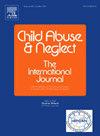虐待性头部创伤的早产儿和足月婴儿的危险因素和结局:一项回顾性比较研究
IF 3.4
2区 心理学
Q1 FAMILY STUDIES
引用次数: 0
摘要
背景:早产是虐待性头部创伤(AHT)的一个危险因素,但之前没有研究将早产儿和足月婴儿与AHT进行比较。目的评估AHT早产儿和足月儿在人口统计学、家庭/环境因素和预后方面的差异。2012年至2020年间,在一家三级儿童医院接受AHT治疗的403名患者(70名早产儿)被纳入研究。方法采用图表法收集资料。采用独立样本t检验、卡方检验和二元logistic回归对早产儿和足月患者的人口统计学、家庭/背景变量和每个Bayley婴儿发育量表的综合评分进行比较。使用重复测量方差分析比较早产患者的胎龄(GA)校正和未校正Bayley评分。结果早产儿的身高(p < .001, d = 0.50)和体重(p < .001, d = 0.44)百分位数明显降低,但未发现其他显著的人口统计学或家庭/背景差异。早产儿的贝利分数比经过GA校正的足月婴儿高,而未经GA校正的足月婴儿得分低。在认知(p < 0.001, η2p = 0.083)、表达语言(p = 0.005, η2p = 0.052)、精细运动(p = 0.001, η2p = 0.045)和大运动(p = 0.008, η2p = 0.031)领域,矫正后的早产儿Bayley得分显著高于未矫正的早产儿。结论:虽然没有观察到人口统计学或家庭/背景变量的显著差异,但年龄校正的Bayley评分明显高于未校正的早产儿AHT评分。本文章由计算机程序翻译,如有差异,请以英文原文为准。
Risk factors and outcomes in preterm versus full-term infants with abusive head trauma: A retrospective comparative study
Background
Premature birth is a risk factor for abusive head trauma (AHT), but no prior studies have compared preterm and term infants with AHT.
Objective
To assess differences in demographics, family/contextual factors, and outcomes between preterm and term infants with AHT.
Participants and setting
403 patients (70 preterm) treated for AHT between 2012 and 2020 at a tertiary care children's hospital.
Methods
Data were collected via chart review. Demographics, family/contextual variables, and a composite score for each Bayley Scales of Infant Development domain were compared between preterm and term patients with independent samples t-tests, chi-square tests, and binary logistic regression. Gestational age (GA) corrected and uncorrected Bayley scores for preterm patients were compared using a repeated measures ANOVA.
Results
Preterm infants had significantly lower height (p < .001, d = 0.50) and weight (p < .001, d = 0.44) percentiles, but no other significant demographic or family/contextual differences were found. Preterm children earned numerically higher Bayley scores than term infants with GA correction and lower scores without correction. Corrected Bayley scores were significantly higher than uncorrected for preterm infants in the Cognitive (p < .001, η2p = 0.083), Expressive Language (p = .005, η2p = 0.052), Fine Motor (p = .001, η2p = 0.045), and Gross Motor (p = .008, η2p = 0.031) domains.
Conclusions
While no significant differences in demographics or family/contextual variables were observed, age corrected Bayley scores were significantly higher than uncorrected scores for preterm infants with AHT.
求助全文
通过发布文献求助,成功后即可免费获取论文全文。
去求助
来源期刊

Child Abuse & Neglect
Multiple-
CiteScore
7.40
自引率
10.40%
发文量
397
期刊介绍:
Official Publication of the International Society for Prevention of Child Abuse and Neglect. Child Abuse & Neglect The International Journal, provides an international, multidisciplinary forum on all aspects of child abuse and neglect, with special emphasis on prevention and treatment; the scope extends further to all those aspects of life which either favor or hinder child development. While contributions will primarily be from the fields of psychology, psychiatry, social work, medicine, nursing, law enforcement, legislature, education, and anthropology, the Journal encourages the concerned lay individual and child-oriented advocate organizations to contribute.
 求助内容:
求助内容: 应助结果提醒方式:
应助结果提醒方式:


